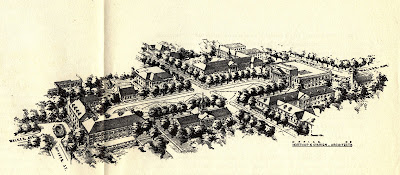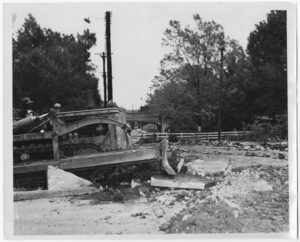From the earliest days of the school, Walker Avenue had bisected campus, forcing students to cross the busy street (often multiple times daily) to access buildings on both sides. The dining halls, science building, home economics building, gymnasium, and many residence halls were all located north of Walker, while the library, Curry, McIver Memorial, student’s building, auditorium, and the administration building were all located south of Walker.
The only safe crossing of the busy avenue was at College Avenue. Over the years, students would cross Walker Ave. via a succession of bridges built to enable foot traffic on College Ave. (running north and south). The bridges were constructed of wood, then iron, and finally concrete in 1928.
Walker Ave. became an increasing busy thoroughfare for autos during the 1940s, a situation that only got worse with the post-war boom. Indeed, Walker Ave. was one of the best east west corridors for residents on the western side of Greensboro seeking to drive to the city center.
So, the stage was set for an impasse when Woman’s College building plans included closing the part of Walker Ave. that bisected the heart of its campus, while the city’s residents wanted to maintain Walker Ave. as way to get to downtown from west Greensboro. In 1945, The Board of Trustees approved a plan of building expansion (more than $3,000,000 to be set aside for buildings) for the school that required Walker Ave. be closed, but they did not have the authority to do so.1 Indeed, the plan sited two new buildings, the library (now Walter Clinton Jackson Library) and an expansion to the home economics building (now Stone Building) directly astride the existing Walker Ave. The Greensboro City Council initially denied the request to close Walker Ave. in August of 1945. Next followed suggestions from closure opponents that the school expand westward or even that a 1,350 foot tunnel should be built from Tate St. to a point between Kenilworth and Stirling Streets.2 Westward expansion would not solve the problem of students needing to cross busy Walker Ave. (nor would it allow for the planned library and home economics building expansion) and it was not expected that the state would furnish another $1,000,000 (the estimated cost of the tunnel) to the millions already proposed to the school for expansion. Thus, the tunnel proposal died.
Still, proponents of the closure of Walker Ave. including Dr. Frank Porter Graham (president of the Consolidated University of North Carolina) W.D. Carmichael, Jr. (comptroller of the University of North Carolina) and Walter Clinton Jackson (chancellor of Woman’s College) among others, worked hard to convince Greensboro and the council to reconsider the closure of Walker Ave. Most arguments were centered around Woman’s College role in the Consolidated University of North Carolina (with Chapel Hill and NC State) and its role as a preeminent school for the education of women. Dr. Graham called Woman’s College the “greatest asset in the building of a greater Greensboro,” and cited closure of Walker Ave. as the “keystone in the college’s great plan for the future.” Carmichael warned that keeping Walker Ave. would block Woman’s College expansion plans and the institution would have no chance to remain competitive with other women’s colleges for growth.3 In a publication to the Greensboro City Council, Dr. Jackson said, “The authorities of the College have made plans for going forward in making this the great institution that it and Greensboro and the State deserve. They are planning great things. They are looking far ahead. They are thinking of the College as it shall be 25 and 50 years from now….It is of the highest importance that the campus we are planning should be a complete unit. The indispensable and fundamental change necessary in carrying out these plans is the closing of Walker Avenue from McIver Street to Forest Avenue.4
Eventually, the proponents for Walker Ave. closing won out. On June 7th, 1947, the City Council adopted a resolution setting the closing of Walker Ave. through Woman’s College on the date that the space was needed for actual construction of a building bridging the avenue. At 1pm on September 24, 1948, barricades were placed on Walker Ave. and work started a few days later on the Library which sits on the former site of Walker Ave.5
**Look for a future post showcasing views of the College Avenue bridge used to cross Walker Avenue!**
By Scott Hinshaw
1- W.C. Jackson to City Council of Greensboro, March 5, 1946
2-“City Authorities Offer Avenue Tunnel Project” Greensboro Daily News, February 26, 1946
3-“College Request for Closing Street Taken under Advisement by Council” Greensboro Daily News, March 6, 1946 **Special thanks to Mark Schumacher for help in tracking down the date of this article!**
4-W.C. Jackson to City Council of Greensboro, March 5, 1946
5-“Walker Avenue Closed Today” Greensboro Daily News, September 24, 1948


